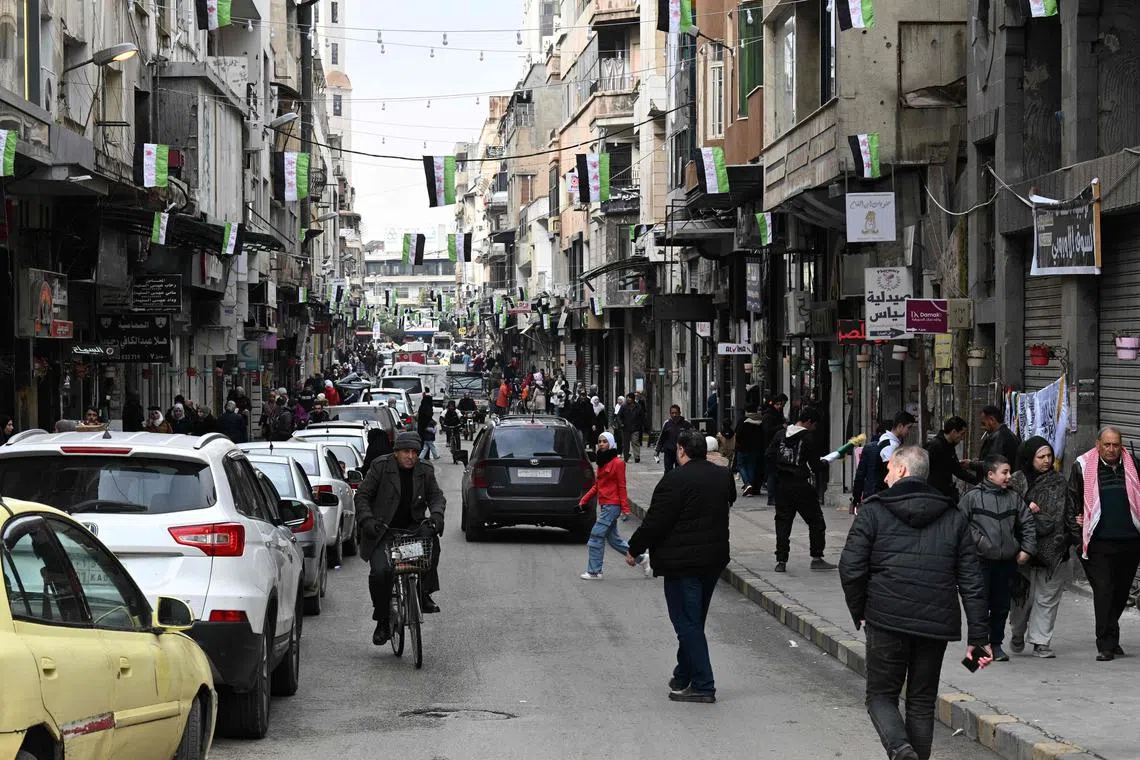Syrians return to Homs, ‘capital of the revolution’
Sign up now: Get ST's newsletters delivered to your inbox

People walking past shops in Homs on Feb 10, 2025.
PHOTO: AFP
Follow topic:
HOMS, Syria – Once dubbed the capital of the revolution against Mr Bashar al-Assad, Homs saw some of the fiercest fighting in Syria’s civil war. Now, displaced people are returning to their neighbourhoods, only to find them in ruins.
It was in Homs that rebels first took up arms to fight Mr Assad’s crackdown on protests in 2011.
The military responded by besieging and bombarding rebel areas such as Baba Amr, where US journalist Marie Colvin and French journalist Remi Ochlik were killed in a bombing in 2012.
Since Mr Assad’s ouster
“The house is burned down, there are no windows, no electricity,” said Ms Duaa Turki at her home in the Khaldiyeh neighbourhood.
“We removed the rubble, lay a carpet” and moved in, said the 30-year-old mother of four. “Despite the destruction, we’re happy to be back. This is our neighbourhood and our land.”
Her husband spends his days looking for a job, she added, while they hope humanitarian workers begin distributing aid to help the family survive.
The siege of Homs lasted two years and killed around 2,200 people, according to the Syrian Observatory for Human Rights.
During the siege, thousands of civilians and rebels were left with nothing to eat but dried foods and grass.
In May 2014, under an evacuation deal negotiated with the former government, most of those trapped in the siege were evacuated. Two years later, Mr Assad seized the last rebel district of Waer.
“We were besieged... without food or water, under air raids, and barrel bombings,” before being evacuated to the rebel-held north, Ms Turki said.
‘Precious soil of Homs’
AFP journalists saw dozens of families returning to Homs from northern Syria, many of them tearful as they stepped out of the buses organised by local activists.
Among them was Mr Adnan Abu al-Ezz, 50, whose son was wounded by shelling during the siege. He later died because soldiers at a checkpoint barred the father from taking him to hospital.
“They refused to let me pass, they were mocking me,” he said with tears in his eyes.
“I knew my house was nearly destroyed, but I came back to the precious soil of Homs.”
While protests and fighting spread across Syria over the course of the 13-year war, Homs’ story of rebellion holds profound symbolism for the demonstrators.
It was there that Mr Abdel Basset al-Sarout, a football goalkeeper in the national youth team, joined the protests and eventually took up arms.
He became something of a folk hero to many before he joined an Islamist armed group and was killed in fighting.
In 2013, his story became the focus of a documentary by Syrian film-maker Talal Derki. Named The Return To Homs, it won international accolades.
Homs returnee Abu al-Moatasim, who remembers Mr Sarout, recounted being detained for joining a protest.
When he saw security personnel approaching in a car, he prayed for “God to drop rocket on us so I die” before reaching the detention centre, one of a network dotted around the country that were known for torture.
His father bribed an officer in exchange for his release a few days later, he said.
‘Build a state’
In Baba Amr, which for a time early in the war was a bastion of the rebel Free Syrian Army, there was rubble everywhere.
The army recaptured the district in March 2012, following a siege and intense bombardment. It was there that Ms Colvin and Mr Ochlik were killed in a bombing of an opposition press centre.
In 2019, a US court found Mr Assad’s government culpable in Ms Colvin’s death, ordering a US$302.5 million (S$406 million) judgment for what it called an “unconscionable” attack that targeted journalists.
Touring the building that housed the press centre, Mr Abdel Qader al-Anjari, 40, said he was an activist helping foreign journalists at that time.
“Here we installed the first internet router to communicate with the outside world,” he added.
“Marie Colvin was martyred here, targeted by the regime because they did not want (anyone) to document what was happening,” he said.
He described her as a “friend” who defied the “regime blackout imposed on journalists” and others documenting the war.
After leaving Homs, Mr Anjari became a rebel fighter, and years later took part in the offensive that ousted Mr Assad on Dec 8, 2024.
“Words cannot describe what I felt when I reached the outskirts of Homs,” he said. Now, he has decided to lay down his arms.
“This phase does not call for fighters, it calls for people to build a state,” he noted. AFP

